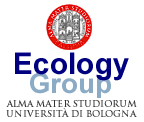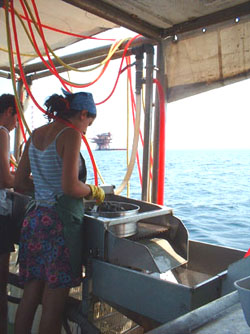
Research Projects
| ONGOING PROJECTS | |
|
The Training Network for Monitoring Mediterranean Marine Protected Areas (MMMPA) is a Marie Curie Initial Training Network (Call FP7-PEOPLE-2011-ITN), funded by the European Commission within the 7th Framework Programme and has started on January 1, 2012. MMMPA aims to train the next generation of MPA scientists and managers, equipping them with a flexible set of skills essential within a wide range of professional environments, including public administration, local authorities, industry and academia. They will focus on the most important aspects that need adequate conservation. In particular, researchers will maturate the experience to: identify species listed in the Barcelona Convention (Protocol ASPIM, Annex II); monitor their distribution and health state; follow adequate experimental designs; evidence spill-over effects; develop fishery management at the local level, develop management guidelines, engage with stakeholders and the society at large. These experiences will stem from a highly interdisciplinary network, leading in taxonomy, ecology, biology conservation, bio-cartography, and socio-economy. Furthermore, they will be trained in a range of soft skills including science communication/outreach, as it is essential at the delicate interface between science, the management of natural assets and the public at large. Training and hands-on experiences will be delivered by a strong network of world-class experts in MPA management which will provide a highly focused learning environment. The consortium includes 7 Full (5 Universities, 1 Research centre, 1 SME) and 7 Associated partners (5MPAs, 2 SMEs), and will recruit 10 Early Stage Researchers (ESRs) and 4 Experienced Researchers (ERs). Both Full and Associated partners have strong collaborative links with other (MPAs) scientists, professionals and managers and are, therefore, well placed to deliver a comprehensive training network. The planned rotation will expose ESR/ERs to each partner, enhancing intersectoral exchanges and strengthening the Mediterranean Research Area by developing an exciting programme that is attractive to the global research community. |
|
| Completed projects | |
| 2001-2004 | EUMAR
- European Marine Genetic Biodiversity
In EUMAR demographic and population genetic data on marine benthic species will be used to assess effects of human activities on genetic biodiversity and to model various threat scenarios. Mechanisms generating biodiversity at the intraspecific level will be addressed experimentally. By combining genetic and demographic modelling with field data from species with varying life-history characteristics, short- and long-term effects of different threats to genetic biodiversity will be outlined. Contact: Marco Abbiati |
 |
BIOMARE
BIOMARE is an AGIP funded research programme to examine multivariate variability in macrobenthic community structure in relation to the presence of gas platforms in the Adriatic Sea. Disturbances caused by human activities have the potential to alter natural patterns, but such disturbances can be difficult to detect or measure because they must be differentiated from a background of natural spatial and temporal variation. Thus, it is necessary to conduct sampling at multiple spatial scales in order to determine patterns with surety. In addition, such sampling is necessary for the generation of useful predictive models of responses of soft-sediment assemblages to environmental gradients or disturbances. The Biomare project was initiated to develop multi-scale monitoring protocols for examining the potential effects of gas platforms on the macrobenthos of the northern Adriatic Sea. The project has several aims: 1) characterisation of variability of soft sediment macrobenthic assemblages at multiple spatial scales, 2) differentiate random variability from that imposed by large-scale environmental gradients, 3) model relationships between gas platforms and benthos. Contact: Laura Airoldi |
| 2001-2005 | PIALASSA
BAIONA -
Monitoring and recovery of the coastal lagoon Pialassa Baiona (Ravenna) The Pialassa Baiona is a brackish coastal lagoon located on the northern Adriatic coast of Italy and connected to the sea through the Ravenna harbour. It hosts a diverse flora and fauna. Baiona is included in the Regional Park of the Po River Delta, and is listed among the Sites of Community Importance, and is included in the Ramsar Convention on Wetlands. The physical parameters are strongly affected by seasons and tides. Nutrient inputs derive from five main channels that drain a watershed of 264 km2, including urban and agricultural areas. Furthermore, the lagoon receives nutrients and contaminants from treatment plants of urban and industrial wastewater, located in along the south side of the lagoon. The lagoon is intensively used for recreational purposes (e.g. hiking, fishing, canoeing) and for commercial harvesting of the manila clam. Monitoring and management of this complex environment requires an integrated approach and the application of efficient sampling design. The main objectives of the project are: (1) to collect all published results from previous studies; (2) to characterise the environmental features of the Pialassa Baiona by applying a interdisciplinary approach, including chemical, geological, hydrological, ecological, biological, human health and economical aspects; (3) to identify potential sources of pollution and environmental disturbance; (4) to estimate the availability of resources for fishing and planning of their sustainable use; (5) to define management priorities and actions to protect and enhance the environmental quality. Partners involved are: The Research Centre for the Environmental Science in Ravenna coordinates the project. Partners of the project are the Regional Environmental Authority (ARPA), the Local Health Service (USL), the Authority of the regional park of the Po river delta. Supported by Ravenna Municipality, Provincial Administration and Industrial Association Coordinator: Professor Marco Abbiati
|
| 2002-2004
|
The
variability of hard substrate assemblages as a tool to estimate
anthropogenic effects on coastal marine environments. COFIN 2002
financed by the Italian Ministry of Education and University
The variability of natural systems reflects many ecological processes that differently affect patterns of species distribution according to the spatial scale of observation. Due to this variability, the generalisation of unreplicated small-scale studies is unreliable. The possibility of carrying out large-scale studies to discriminate the sources of natural variability from those induced by human activities is the prerequisite to understand both the effects of pollutants and the efficacy of protection over an area, as is the case of Marine Protected Areas. This research project aims (1) to quantify natural patterns of distribution of hard-substrate sessile assemblage at a hierarchy of spatial scales and (2) to set up proper monitoring protocols for the study of these assemblages along all Italian coasts. Studies deal with assemblages relevant for their biodiversity and which have been identified as indicators of anthropogenic and climatic effects by previous studies. The research units have jointly developed efficient and rapid sampling techniques so as to provide a basis for a large-scale monitoring network of marine coastal systems. Contact: Laura Airoldi |
| 2003-2006 | ‘Tegnůe’ di Chioggia monitoring project. Financed by the Regione Veneto
‘Tegnůe’ are rocky outcrops emerging for the muddy and sandy bottoms of the northern Adriatic Sea. These structures are hosting an incredible reach and diverse marine life. In the year 2003 the Associazione Tegnůe di Chioggia, in collaboration with our lab, ICRAM (Stazione Idrobiologica di Chioggia), the Universitŕ di Padova (Dept of Biology) and the CNR (Institute of Marine Science of Venice) obtained by the Italian Government the creation of a “Zona di Tutela Biologica” to protect this unique environment. Following the institution of the ZTB, the Regional Government of Veneto funded a 3 years research project for the monitoring of the area. The Tegnůe are affected by both natural (e.g. anoxic crisis) and anthropogenic (e.g. trawling, diving) disturbance. Analysing patterns of distribution of species provides the basic knowledge for identifying and understanding ecological processes that shape natural assemblages and to apply the best available methodology for the conservation purposes. The potential role of habitat heterogeneity in influencing the composition and distribution of species of algae and animals will be assessed. These data provide the necessary background to evaluate the efficiency of the protection measures applied and to improve the management strategies. Contact: Massimo Ponti |
| 2003-2004
|
Beach nourishment using underwater sand: assessment of impacts on coastal benthic assemblages. Financed by the Regione Emilia Romagna
Coastal erosion is one of the major issues that the Regional Environmental Agency (ARPA) has been facing during the last decades. In the year 2002 a large project for the nourishment of several beaches of Romagna, using sand excavated from the deep-water banks has been carried on. This approach is considered to be effective in protection from coastal erosion, with a limited impact on the costal assemblages. However, deep-water sand differs from costal send in both the geological and ecological features. Deep water-sand has a larger grain size and a different composition in terms of shell debris and associated living fauna. This project aimes to quantify changes in costal species assemblages due to beach nourishment, both in areas protected by breakwaters and on the open coast. The final goal is to develop an optimal impact study design to be used in a BACI assessment (Before vs After/Control vs Impact) in future beach restoration projects. Contact: Marco Abbiati and Francesco Colosio |
| 2004-2006 | TW
References Net - Management and sustainable development of protected transitional
waters.
Submitted to EU European Community Initiative INTERREG III B CADSES
The project is designed to improve and reinforce conservation of natural heritage in protected transitional ecosystems through functional networking and promotion of pilot actions, enlarging fruition of economic and social components. The strategic objective are: (1) to overcome fragmentation of expertises and activities on protected transitional ecosystems in the CADSES area, by networking scientific, socio-economic and decision-maker components; (2) to translate the efforts on conservation into sustainable development strategies, creation of new jobs opportunities and improvement of quality of life. To reach its aims and to achieve its strategic objectives the project has a number of specific objectives, which are organized into the following areas: environmental, socio-economic, and networking-communication. Contact: Marco Abbiati and Massimo Ponti |
| 2004-2006
|
Fish and Chips
The aim of the project is the development of DNA chips for the identification of marine organisms in European Seas as a cost effective, reliable and efficient technology in biodiversity and ecosystem science. The project combines taxonomic expertise with genetic expertise to identify marine organisms that will be used for sequencing of suitable molecular markers for probe design. This will be done by biotech research centres in connection with SMEs engaged in bioinformatics and DNA chip technology. |
| Replat
Decommissioning of off-shore platforms is among the major environmental issues the oil industry has to address. Several options have been applied in different off-shore fields, however, effectiveness and environmental compatibility of decommission strategies must be evaluated on a local basis. The aim of the project is to develop an integrated approach for platform decommissioning, taking into account environmental sustainability, technical feasibility and the economic aspects of the different scenarios. The possibility of reconverting the off shore platforms to different uses will be also considered. Contact: Marco Abbiati |
|
| 2004-2006 | Biological Protection Zone in Chioggia
The main goals are to evaluate the effects of the Biological Protection Zone of Tegnůe di Chioggia on the demersal and benthic assemblages. The possibility of restocking commercial species will be investigated. Italian Ministry of Agricultural and Forestry Politics. Contact: Marco Abbiati and Massimo Ponti |
| 2000-2004
|
DELOS
- Environmental
Design
of Low Crested Coastal Defence Structures
As low crested structures we mean structures which are regularly overtopped by waves; most artificial structures of this type along European shores are constructed with rubble mound jetties, the analysis is restricted therefore to this type of structures and to natural boulder reef as term of comparison. The principal expected achievements are:
Contact: Laura Airoldi |
Last update: 13/03/2012